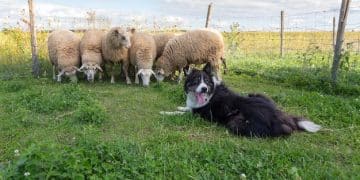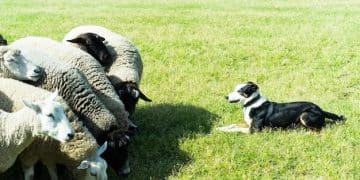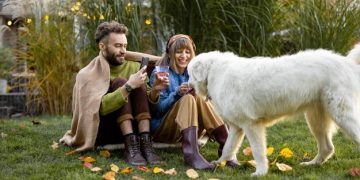Sporting Dog Breeds in 2025: Profiles & Exercise Needs for US Owners

Sporting dog breeds require significant exercise and mental stimulation, making them ideal companions for active owners in the US seeking to incorporate outdoor activities and training into their 2025 lifestyle.
Thinking about adding a furry, four-legged athlete to your family in 2025? If you’re an active individual or family in the US, then exploring sporting dog breeds might just be the perfect match. These dogs are bred for energy and enthusiasm, but understanding their breed profiles and exercise needs is crucial for a happy and healthy partnership.
Understanding the Sporting Dog Group
The Sporting Group, as defined by the American Kennel Club (AKC), encompasses breeds originally developed to assist hunters in the field. These dogs are known for their natural instincts in water and woods, making them excellent retrievers and pointers. Understanding their history helps in appreciating their inherent energy and need for stimulation.
Common Traits of Sporting Dogs
Sporting dogs generally share several key characteristics, making them distinct from other breed groups. These traits influence their suitability as pets and their specific needs.
- High energy levels: Bred for long days of hunting, they require substantial exercise.
- Intelligence and trainability: They are quick learners and eager to please, responding well to training.
- Friendly and sociable nature: Typically good with people and other dogs, though socialization is still essential.
These inherent traits mean that sporting dogs thrive in active households where they receive ample physical and mental engagement. Without it, they can become bored and potentially destructive.
Recognizing these traits is the first step in determining if a sporting dog breed is the right fit for your lifestyle. Their energy and intelligence make them rewarding companions for those prepared to meet their needs.
Popular Sporting Dog Breeds and Their Profiles
Within the Sporting Group, various breeds offer unique characteristics and temperaments. Exploring these profiles can help you narrow down your choices based on your lifestyle and preferences.
Labrador Retriever
The Labrador Retriever is consistently ranked as one of the most popular breeds in the US. Known for their friendly and outgoing personalities, they make excellent family pets.
- Temperament: Affectionate, patient, and eager to please.
- Exercise Needs: High; requires daily walks, runs, and playtime.
- Grooming: Minimal; regular brushing to manage shedding.
Labradors thrive on interaction and excel in activities like swimming and fetching. Their versatility and gentle nature make them a great choice for active families with children.
Golden Retriever
Similar to Labradors, Golden Retrievers are known for their gentle and affectionate personalities. They are intelligent and highly trainable, making them excellent companions for various activities.
- Temperament: Kind, intelligent, and devoted.
- Exercise Needs: High; needs daily exercise and mental stimulation.
- Grooming: Moderate; requires regular brushing to prevent matting.
Golden Retrievers are great with children and other pets, excelling in activities such as agility, obedience, and therapy work. Their adaptability and loving nature make them ideal family dogs.

Both Labrador and Golden Retrievers are wonderful choices, providing companionship and requiring engaged owners. Consider your commitment level to their considerable exercise needs.
Essential Exercise Needs for Sporting Dogs
Meeting the exercise needs of sporting dogs is crucial for their physical and mental well-being. Insufficient exercise can lead to behavioral problems and health issues. A structured approach ensures they get the activity they require.
Daily Physical Exercise
Sporting dogs need more than just a quick walk around the block. They require structured exercise that allows them to expend their energy.
- Daily walks or runs: Aim for at least 30-60 minutes of brisk walking or running.
- Playtime: Incorporate games like fetch, Frisbee, or tug-of-war.
- Swimming: If possible, swimming is an excellent low-impact exercise.
Regular physical activity helps keep them in shape and prevents boredom-related behaviors, reinforcing good habits and reducing the likelihood of destructive actions.
Mental Stimulation
In addition to physical exercise, mental stimulation is vital for sporting dogs. Engaging their minds helps prevent boredom and keeps them sharp.
- Training sessions: Regular obedience or agility training.
- Puzzle toys: Use toys that require them to solve problems to get treats.
- Interactive games: Hide-and-seek or other games that engage their senses.
Combining physical and mental activity ensures a well-rounded approach to their well-being, contributing to a more balanced and happy dog.
Providing this comprehensive approach helps manage the high energy levels of sporting dogs, strengthening the bond between owner and pet.
Adapting Exercise to Different Sporting Breeds
While all sporting dogs share a need for exercise, the specific types and intensity can vary depending on the breed. Tailoring your approach ensures you meet your dog’s individual needs effectively.
Breed-Specific Considerations
Consider the breed’s original purpose when planning exercise routines. Retrievers enjoy fetching, while pointers may prefer scent work.
- Retrievers: Activities like retrieving balls or dummies in water or fields.
- Pointers and Setters: Opportunities to use their scenting abilities through tracking games.
- Spaniels: Activities that involve flushing and retrieving, such as field trials or hunting simulations.
Understanding these breed-specific preferences can make exercise more enjoyable and engaging for your dog, strengthening your relationship.
Age and Health Factors
Always adjust exercise routines based on your dog’s age and health. Puppies have different needs than adult dogs, and older dogs may require modified activities.
- Puppies: Shorter, more frequent play sessions to avoid overexertion.
- Adult Dogs: Regular, consistent exercise routines to maintain fitness.
- Senior Dogs: Gentle walks and low-impact activities to accommodate joint issues.

Regular veterinary check-ups can help identify any underlying health issues that may impact your dog’s ability to exercise safely. Adjust activities accordingly to ensure their comfort and well-being.
By tailoring exercises to your dog’s specific breed, age, and health, you can create a sustainable and enjoyable routine that benefits both you and your furry friend. Consistency and adaptability are key to long-term success.
The Importance of Socialization for Sporting Dogs
Socialization is a critical aspect of raising a well-adjusted and happy sporting dog. Early and ongoing exposure to different people, places, and situations helps them develop into confident and well-behaved companions.
Early Socialization
Start socializing your sporting dog puppy as early as possible, ideally between 8 and 16 weeks of age. This is a critical period for learning and development.
Expose your puppy to a variety of sights, sounds, and experiences. This can include:
- People of different ages, races, and appearances
- Various environments, such as parks, streets, and pet stores
- Different sounds, such as traffic, children playing, and household appliances
Positive and controlled interactions during this period can prevent fear and aggression later in life. Enroll in puppy classes to ensure supervised socialization and basic training.
Ongoing Socialization
Socialization should not stop after puppyhood. Continue to expose your sporting dog to new experiences throughout their life.
Regular outings to parks, dog-friendly stores, and social events can help maintain their confidence and social skills. Consider the following:
- Organize playdates with other dogs
- Take them to dog-friendly cafes or restaurants
- Attend community events where dogs are welcome
Continued socialization reinforces positive behaviors and prevents the development of anxieties or phobias. A well-socialized sporting dog is more likely to be a happy and well-behaved member of the family and community.
By prioritizing early and ongoing socialization, you can help your sporting dog develop into a confident, well-mannered, and enjoyable companion. A well-socialized dog is a happier dog, and a joy to be around.
Nutrition and Diet for Active Sporting Dogs
Proper nutrition is essential for maintaining the health and energy levels of active sporting dogs. Feeding them a balanced diet that meets their specific needs ensures they can perform at their best and stay healthy for years to come.
Nutritional Requirements
Sporting dogs require a diet rich in protein and healthy fats to support their high energy levels. Choose a high-quality dog food specifically formulated for active breeds.
Look for the following key nutrients:
- Protein: Supports muscle development and repair.
- Fats: Provides energy and supports healthy skin and coat.
- Carbohydrates: Offers additional energy for physical activity.
Avoid foods with excessive fillers, artificial colors, or preservatives. Consult with your veterinarian to determine the appropriate calorie intake based on your dog’s age, weight, and activity level.
Feeding Schedules and Portions
Establish a consistent feeding schedule to regulate your dog’s metabolism and prevent overeating. Divide their daily food ration into two or three meals.
Monitor their body condition regularly to ensure they are maintaining a healthy weight. Adjust portion sizes if necessary to prevent weight gain or loss. Consider the following tips:
- Use a measuring cup to ensure accurate portion control
- Avoid feeding table scraps, which can lead to weight gain and digestive issues
- Provide access to fresh, clean water at all times
Proper nutrition is a cornerstone of your sporting dog’s health and well-being. A balanced diet, coupled with regular exercise, will help them thrive and enjoy a long and active life.
By prioritizing their nutritional needs, you are investing in their overall health and happiness. A well-nourished sporting dog is more likely to be energetic, resilient, and a joy to be around.
Conclusion
Choosing a sporting dog breed means committing to an active lifestyle. By acknowledging their breed profiles and exercise needs, owners in the US can create fulfilling relationships with these energetic companions in 2025.
| Key Point | Brief Description |
|---|---|
| 🏃 Exercise Needs | Sporting breeds require high levels of daily physical and mental stimulation. |
| 🐕 Breed Variety | From Retrievers to Spaniels, each breed has unique traits and exercise preferences. |
| 🧑🤝🧑 Socialization | Early and consistent socialization is essential for a well-adjusted dog. |
| 🍎 Nutrition | Proper nutrition fuels their active lifestyle. |
Frequently Asked Questions About Sporting Dog Breeds
▼
Sporting breeds were originally bred to assist hunters, excelling in retrieving game and pointing or setting to locate birds. They are known for their high energy and natural instincts suited to outdoor activities.
▼
Each sporting dog requires a significant amount of exercise, typically at least 30-60 minutes of vigorous activity daily. This can include running, swimming, or engaging in interactive games.
▼
Labrador Retrievers and Golden Retrievers are popular sporting breeds for families, valued for their friendly nature. Brittany Spaniels and Vizslas are also great choices for active owners.
▼
Socialization is crucial for sporting dogs to avoid aggression and fear. Early and ongoing exposure to various environments ensures that they become a confident well-behaved, happy member of the family.
▼
Active sporting dogs should be fed a high-quality diet rich in protein and healthy fats. This diet is designed to support their energy levels and overall health. Consult with a vet for custom recommendations.
Conclusion
By understanding and meeting the exercise, socialization, and nutritional needs of these breeds, US owners can ensure a happy and thriving life alongside their energetic sporting dog companions.





